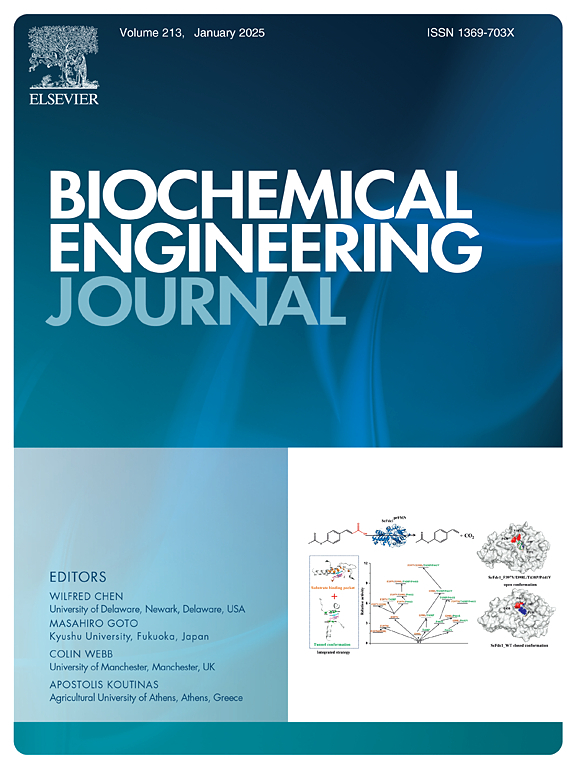不同结构特征的真菌协同作用可提高锂从鳞片石中的沥滤效果
IF 3.7
3区 生物学
Q2 BIOTECHNOLOGY & APPLIED MICROBIOLOGY
引用次数: 0
摘要
本研究旨在探索微生物共培养对锂从鳞片石中浸出的改善作用,重点关注不同结构真菌在改善生物系统浸出性能方面的协同效应。结果表明,在单一浸出实验中,多细胞真菌和单细胞酵母菌的作用较弱。多细胞真菌受限于 EPS 分泌不足,而单细胞酵母菌是非菌丝生物,产酸能力弱,对矿物质的作用有限。但在联合浸出实验中,种间协作促进了两种菌株的合成代谢活动,使有机酸、多糖、蛋白质和腐殖质的种类和含量发生了变化。柠檬酸的含量在 22 d 左右达到最高值 16.98 g-L-1,单细胞酵母菌分泌的 EPS 促进了多细胞真菌的菌丝粘附和矿物包裹。两者的联合作用增强了酸化、络合和菌丝破坏的效果,提高了浸出效果。该研究揭示了不同结构真菌对鳞片石浸出的协同代谢机制,验证了微生物共培养对提高浸出率的有效性,为工业应用提供了依据。此外,共培养技术的使用还对商业生产和环境保护产生了积极影响。本文章由计算机程序翻译,如有差异,请以英文原文为准。
The synergistic interaction of fungi with different structural characteristics improves the leaching of lithium from lepidolite
The aim of this study was to explore the improvement of lithium leaching from lepidolite by microbial co-culture, focusing on the synergistic effect of different structural fungi in improving the leaching performance of biological systems. The results showed that in the single leaching experiment, the multicellular fungi and the unicellular yeast showed weak effects. Multicellular fungus is limited by insufficient EPS secretion, while unicellular yeast is non-mycelial organisms with weak acid production capacity and limited effect on minerals. However, in the combined leaching experiment, the interspecific collaboration promoted the synthetic and metabolic activity of the two strains, resulting in changes in the type and content of organic acids, polysaccharides, proteins and humus. The content of citric acid reached the highest value of 16.98 g·L−1 at about 22 d, and the EPS secreted by unicellular yeast promoted the mycelium adhesion and mineral wrapping of multicellular fungi. The combined action of the two enhanced the effects of acidification, complexation and mycelium destruction, and improved the leaching effect. This study revealed the synergistic metabolic mechanism of lepidolite leaching by fungi with different structures, verified the effectiveness of microbial co-culture to improve the leaching rate, and provided a basis for industrial application. In addition, the use of co-culture technology has a positive impact on commercial production and environmental protection.
求助全文
通过发布文献求助,成功后即可免费获取论文全文。
去求助
来源期刊

Biochemical Engineering Journal
工程技术-工程:化工
CiteScore
7.10
自引率
5.10%
发文量
380
审稿时长
34 days
期刊介绍:
The Biochemical Engineering Journal aims to promote progress in the crucial chemical engineering aspects of the development of biological processes associated with everything from raw materials preparation to product recovery relevant to industries as diverse as medical/healthcare, industrial biotechnology, and environmental biotechnology.
The Journal welcomes full length original research papers, short communications, and review papers* in the following research fields:
Biocatalysis (enzyme or microbial) and biotransformations, including immobilized biocatalyst preparation and kinetics
Biosensors and Biodevices including biofabrication and novel fuel cell development
Bioseparations including scale-up and protein refolding/renaturation
Environmental Bioengineering including bioconversion, bioremediation, and microbial fuel cells
Bioreactor Systems including characterization, optimization and scale-up
Bioresources and Biorefinery Engineering including biomass conversion, biofuels, bioenergy, and optimization
Industrial Biotechnology including specialty chemicals, platform chemicals and neutraceuticals
Biomaterials and Tissue Engineering including bioartificial organs, cell encapsulation, and controlled release
Cell Culture Engineering (plant, animal or insect cells) including viral vectors, monoclonal antibodies, recombinant proteins, vaccines, and secondary metabolites
Cell Therapies and Stem Cells including pluripotent, mesenchymal and hematopoietic stem cells; immunotherapies; tissue-specific differentiation; and cryopreservation
Metabolic Engineering, Systems and Synthetic Biology including OMICS, bioinformatics, in silico biology, and metabolic flux analysis
Protein Engineering including enzyme engineering and directed evolution.
 求助内容:
求助内容: 应助结果提醒方式:
应助结果提醒方式:


